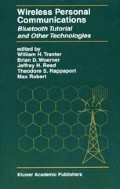Abstract
Third-generation (3G) wireless systems need strategies to further improve performance, increase data rates and at the same time provide flexible and affordable support for multi-services and multi-standards. Software radio technology is promising to provide the required flexibility in radio frequency (RF), intermediate frequency (IF) and baseband signal processing stages. Smart antenna can greatly improve system performance, enhance system capacity by making use of spatial processing, exploiting the spatial directivity and reducing co-channel interference. This paper addresses the downlink capacity gain of the multiple beam smart antennas in GSM link Frequency Hopping (FH)-TDMA system. The system capacity is studied. Analytical results are compared with the sectorization-only application. Perfect power control and discontinuous transmission (using voice activity) are taken into consideration in the analysis. One possible software radio architecture for a base station with smart antenna is proposed. In this architecture, smart antenna algorithms might be dynamically reconfigured according to different environment requirements and the baseband processing might also be dynamically reconfigured according to different standard requirements. In this way, the need for flexibility is satisfied.
Access this chapter
Tax calculation will be finalised at checkout
Purchases are for personal use only
Preview
Unable to display preview. Download preview PDF.
References
Mohamed Ahmed and Samy Mahmoud, “Capacity Analysis of GSM Systems using Frequency Hopping and Smart Antennas,” To be Published in IEEE VTC2000, Tokyo, Japan, May 2000.
Mohamed Ahmed, Wei Wang, and Samy Mahmoud, “Downlink Capacity Enhancement in GSM Systems with Frequency Hopping and Multiple Beam Smart Antennas,” To be Published in ICC2000.
T. Chebaro, “Capacity evaluation of a frequency hopped TDMA cellular radio system,” Annaels des Telecommunications, vol. 51, Mar.–Apr. 1996
J. Johansen and B. Vejlgaard, “Capacity analysis of a frequency hopping GSM system,” Master thesis, Alborg University 1995.
G Tunnicliffe, A. Sathyendran and A. Murch, “Performance improvement in GSM networks due to slow frequency hopping,” IEEE VTC 1997.
C.-C. Lee and R. Steele, “Signal-to-interference calculations for modern TDMA cellular communication systems,” IEE Proceedings-Communications, Vol. 142, No. 1, Feb. 1995.
S. Channakeshu, A. Hassan, J. Anderson and B. Gudmundson. “Capacity analysis of a TDMA-based slow-frequency-hopped cellular system,” IEEE Trans. on Vehicular Technology, Vol. 45, No. 3, Aug. 1996.
J. Dornstetter and D. Verhulst, “Cellular efficiency with slow frequency hopping: Analysis of the digital SFH900 mobile system,” IEEE JSAC, Vol. 5, No. 5, June 1987.
L. Godara, “Applications of antenna arrays to mobile communications, Part I: Performance improvement, feasibility, and system considerations,” Proc. of the IEEE, Vol. 85, No. 7, July 1997.
J. Winters, “Smart antennas for wireless systems,” IEEE Personal Communications, Feb. 1998.
M. Wells, “Increasing the capacity of GSM cellular radio using adaptive antennas,” IEEE Proceedings-Communications, Vol. 143, No. 5, Oct. 1996
J. Mitola III, “Software Radio Architecture and Technology,” Proc. 1998 Int’l. Symp. Adv. Radio Tech., Boulder, CO, Sept. 1998.
F. Riera-Palou, C. Chaikalis, J.M. Noras, “Reconfigurable mobile terminal requirements for third generation applications”, UMTS Terminals and Software Radio (Ref. No. 1999/055), IEE Colloquium, pp: 9/1–9/6, 1999.
A. Wiesler, H. Schober, R. Machauer, F. Jondral, “Software radio structure for umts and second generation mobile communication systems”, Vehicular Technology Conference, 1999. VTC 1999-Fall. IEEE VTS 50th, Vol. 2, pp: 939–942, 1999.
J. Kennedy, M.C. Sullivan, “Direction finding and smart antennas using software radio architectures” IEEE Communications Magazine, Vol. 335, pp: 62–68. May 1995.
R. Kohno, “Software antenna and its communication theory for mobile radio communications”, Personal Wireless Communications, 1997 IEEE International Conference, pp: 227–233, 1997.
T. Turletti, D. Tennenhouse, “Complexity of a software GSM base station”, IEEE Communications Magazine, Vol. 372, pp: 113–117, Feb. 1999.
Author information
Authors and Affiliations
Editor information
Editors and Affiliations
Rights and permissions
Copyright information
© 2002 Kluwer Academic Publishers
About this chapter
Cite this chapter
Wang, W., Ahmed, M., Mahmoud, S., Hafez, R.H.M. (2002). Downlink Capacity Enhancement in GSM System Using Multiple Beam Smart Antenna and SWR Implementation. In: Tranter, W.H., Woerner, B.D., Reed, J.H., Rappaport, T.S., Robert, M. (eds) Wireless Personal Communications. The International Series in Engineering and Computer Science, vol 592. Springer, Boston, MA. https://doi.org/10.1007/0-306-46986-3_9
Download citation
DOI: https://doi.org/10.1007/0-306-46986-3_9
Publisher Name: Springer, Boston, MA
Print ISBN: 978-0-7923-7214-1
Online ISBN: 978-0-306-46986-2
eBook Packages: Springer Book Archive

